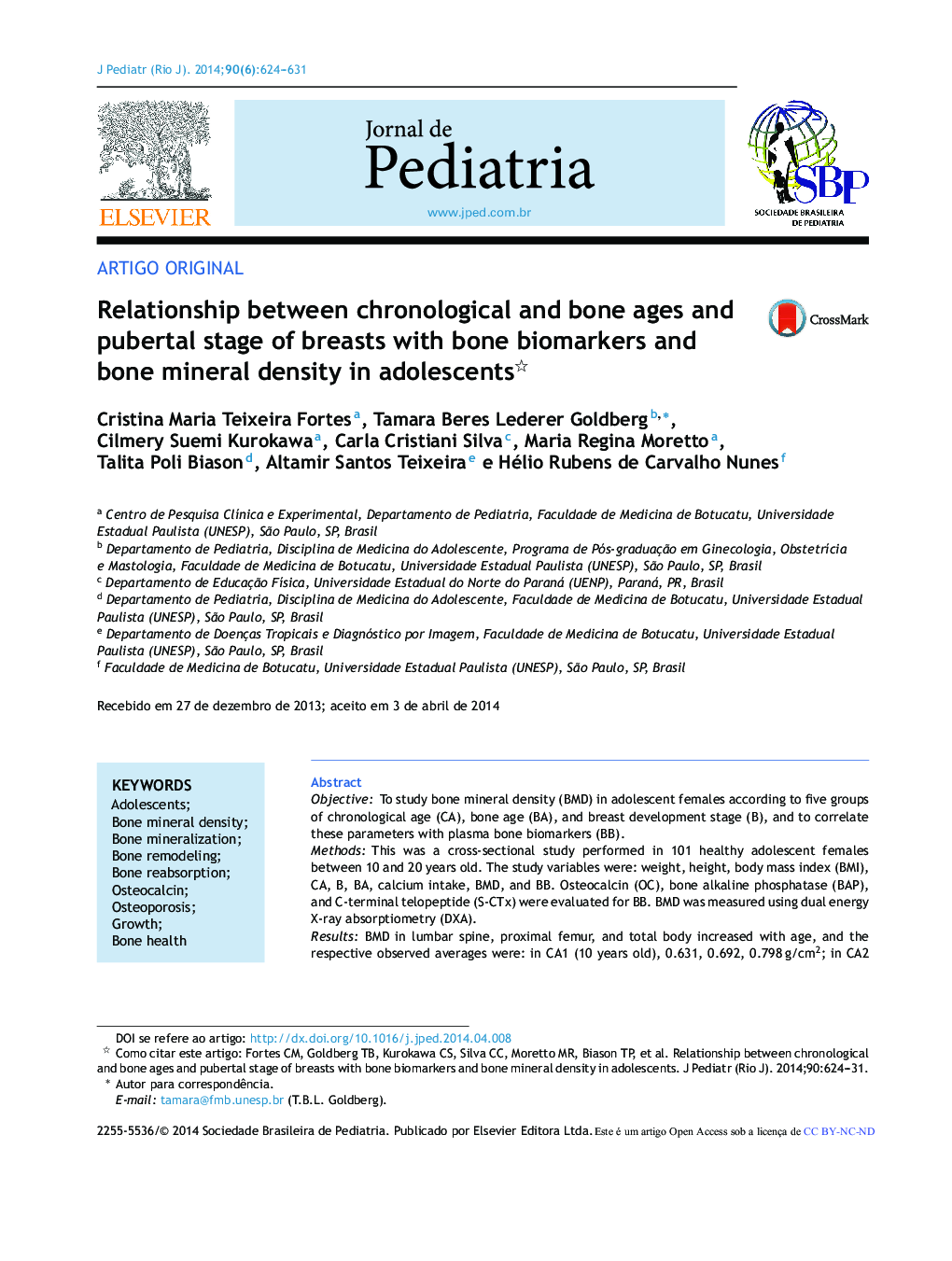| کد مقاله | کد نشریه | سال انتشار | مقاله انگلیسی | نسخه تمام متن |
|---|---|---|---|---|
| 4154394 | 1607079 | 2014 | 8 صفحه PDF | دانلود رایگان |
ObjectiveTo study bone mineral density (BMD) in adolescent females according to five groups of chronological age (CA), bone age (BA), and breast development stage (B), and to correlate these parameters with plasma bone biomarkers (BB).MethodsThis was a cross‐sectional study performed in 101 healthy adolescent females between 10 and 20 years old. The study variables were: weight, height, body mass index (BMI), CA, B, BA, calcium intake, BMD, and BB. Osteocalcin (OC), bone alkaline phosphatase (BAP), and C‐terminal telopeptide (S‐CTx) were evaluated for BB. BMD was measured using dual energy X‐ray absorptiometry (DXA).ResultsBMD in lumbar spine, proximal femur, and total body increased with age, and the respective observed averages were: in CA1 (10 years old), 0.631, 0.692, 0.798 g/cm2; in CA2 (11 to 12 years old), 0.698, 0.763, 0.840 g/cm2; in CA3 (13 to 14 years old), 0.865, 0.889, 0.972 g/cm2; in CA4 (15 to 16 years old), 0.902, 0.922, 1.013 g/cm2; and in CA5 (17 to 19 years old), 0.944, 0.929, 1.35 g/cm2. These results showed significant differences between 13 and 14 years of age (CA3) or when girls reached the B3 stage (0.709, 0.832, 0.867 g/cm2). The highest median concentrations of BB were between 10 and 12 years of age when adolescents were in the B2–B3 (p < 0.001). Median BB concentrations decreased in advanced BA and B.ConclusionsBB concentrations were positively correlated with the peak height velocity and negatively correlated with BMD in the study sites. Increased BMD and BB concentrations were observed in B3.
ResumoObjetivoAvaliar a densidade mineral óssea (DMO) em adolescentes do sexo feminino de acordo com a idade cronológica (IC), idade óssea (IO) e desenvolvimento das mamas (M) e suas correlações com biomarcadores de remodelação óssea em plasma (BO).MétodosEste foi um estudo transversal prospectivo feito em 101 adolescentes saudáveis do sexo feminino com idade entre 10 e 20 anos. As variáveis estudadas foram: peso, altura, índice de massa corpórea (IMC), IC, IO, M, ingestão de cálcio, DMO e BO. A osteocalcina (OC), fosfatase alcalina óssea (BAP) e o telopeptídeo C terminal (S‐CTx) foram os biomarcadores de remodelação óssea avaliados. A DMO foi obtida por absorciometria de raios‐X de dupla energia (DXA).ResultadosA DMO de coluna lombar, fêmur proximal e corpo total aumentou com a idade, e as respectivas médias observadas foram: IC1 = 0,631, 0.692, 0,798 g/cm2; IC2, 0,698, 0,763, 0,840 g/cm2; IC3, 0,865, 0,889, 0,972 g/cm2; IC4, 0,902, 0,922, 1,013 g/cm2; e IC5, 0,944, 0,929, 1,35 g/cm2. Observou‐se diferença significativa entre 13 e 14 anos (IC3) ou quando as meninas estavam em M3 (0,709, 0,832, 0,867 g/cm2). Os valores dos BO apresentaram elevação entre 10 e 12 anos e quando as adolescentes estavam em M2–M3 (p < 0,001). Os valores das medianas dos BO diminuíram com o avançar da IO e M.ConclusõesOs BOs mostraram paralelismo com o pico de velocidade de crescimento e demonstraram correlação negativa com a DMO no sítios avaliados. O aumento da DMO e dos BOs foi observado em M3.
Journal: Jornal de Pediatria (Versão em Português) - Volume 90, Issue 6, November–December 2014, Pages 624–631
